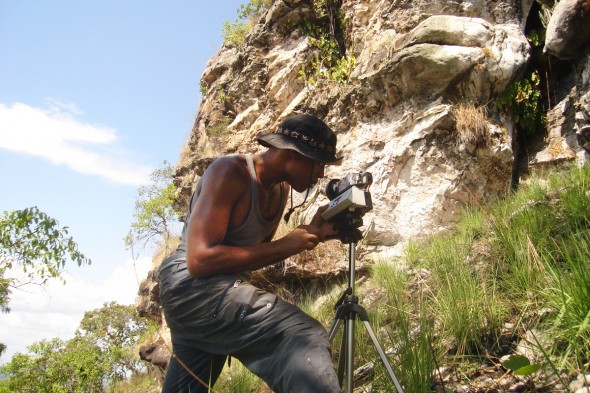Anthropologist digs new insights from ancient rock art

Christopher Davis, doctoral candidate in anthropology, studies rock art in the Amazon, including paintings that are 13,000 years old. “It is possibly the oldest evidence of ancient astronomy, and a calendar, in the Americas,” he says.
The Stone Age rock art that Christopher Davis studies in the Amazon is more than just prehistoric pictures.
“It is possibly the oldest evidence of ancient astronomy, and a calendar, in the Americas,” said Davis, a Ph.D. candidate in anthropology.
At 13,000 years old, some of the paintings are “much older than the period of megalithic construction of [Egyptian] pyramids or Stonehenge,” Davis said.
(The pyramids are around 4,500 years old; Stonehenge, in England, no more than 5,000.)
Painted on mountain and cave walls, the art “also contains one of the oldest systems of notation in the world,” said Davis, who will present his research Saturday at a meeting of the American Anthropological Association in Chicago.
Davis first saw the paintings six years ago while on a dig with Anna Roosevelt, archaeologist and professor of anthropology.
They visited the rock art site in the mountains near Monte Alegre, Brazil, along the Amazon River. The mountains are part of an arc that was formed by a long-extinct volcano.
Davis, whose research is supported by a Fulbright Full Grant, has examined more than 300 painted images, some in groups and others standing alone.
Many represent sun halos, which are formed by upper-atmosphere ice crystals.
Two degrees south of the equator, there is no cold weather in winter, change of leaf colors in autumn or significantly longer daylight hours in summer.
Instead, where the sun passes in the sky determines the time of year. Recording its position enabled ancient people “to plan their activities around annual occurrences — the rainy and dry seasons, the flooding of rivers, the availability of animals and edible plants,” Davis said.
“It gave them a calendar — the oldest one in the Americas.”
In addition to the sun, paintings represent stars, comets and eclipses. Some have hand prints superimposed on them, in red or yellow paint.
“This evidence suggests the area had become a pilgrimage site,” Davis said.
Many tribes had a creation myth that the sun and moon were people, the first on Earth.
“We suspect a reverence for the images developed in later cultures,” he said. “By touching them, people might have believed they would be imbued with power.”
In the caves, Davis found representations of animals, with a focus on a particular creature in each cave. One had a large image of an owl, with layers of small bones from owl “pellets” or excreta on the floor. Another depicted what looked like a frog in a climbing pose.
“One day I was taking pictures when I heard a thud,” Davis said. “I turned around and saw a black frog with a bat in its mouth” — which could explain why the pictured frog seemed to be climbing.
Other outdoor paintings depict bats, monkeys, opossums or birds. There are humans, too, facing front, usually with stick arms and legs bent at right angles.
Davis became interested in the art because of the mysteries of why it was there and when it was made.
“I never knew there was rock art in South America — I knew about it being in Europe, Africa and Australia,” he said.
Scientists believed for years that early people entered North America around 12,000 years ago, across what was then a land bridge in the Bering Strait between Asia and Alaska.
“Due to more recent research by my adviser and other scholars, that date has been pushed back a few thousand years, and the previous notion of just hunters trickling into the Americas in pursuit of large animals now includes broad-spectrum foragers skirting along the coast in small boats.
“My research adds an extra dimension to the South American tradition — one that includes those early people orienting themselves to their new environment by using rock art to mark important observations.”
Davis grew up on Chicago’s South Side, in the London Towne neighborhood between 100th Street and Cottage Grove Avenue and the Bishop Ford Expressway.
He earned a bachelor’s degree in chemistry from Dartmouth College and a master’s in anthropology from UIC.
Davis now lives in Bronzeville with his wife, Carmen, a Brazilian who was taking an archeology class when he met her while doing his research. They have a son, Amani, born July 6.
Davis will defend his doctoral dissertation by the end of the year.
“Post-Ph.D. I hope to be a professor at a research institution,” Davis said. “And I plan to do more research at my site in Monte Alegre.”
